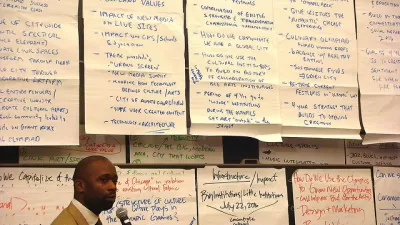The movement stems from demographic changes in the work force. For companies seeking younger hires, they need to go to where they prefer to live. Suburban campuses may be replaced by urban headquarters or the addition of satellite offices in cities.

Lauren Weber points to many "corporate giants abandoning vast suburban campuses for urban offices nearer to the young, educated and hyper-connected workers who will lead their businesses into the digital age." While her focus is the Chicago area, she includes examples from throughout the country.
"The showcase headquarters of the past, the beautiful suburban campuses—that's a very obsolete model now," said Patrick Phillips, CEO of the Urban Land Institute, a land-use think tank.
Vacancy rates reflect the "back to the city" movement. In 2013, 13,9% of urban space stood empty compared with 18.5% in suburbs.
"There's increasing evidence that this represents a broad trend among large and middle-size companies," said Enrico Moretti, an economist at the University of California, Berkeley, and author of "The New Geography of Jobs."
For companies who choose to say put, many "are opening or expanding urban satellite offices, especially for technology and research staff working on product development and innovation, according to Mr. Moretti."
Lauren Weber goes into more detail in an audio version of the article with host Gordon Deal of "The Wall Street Journal This Morning" accessible from the article.
The same article also appears in Yahoo! Finance.
FULL STORY: Companies Say Goodbye to the 'Burbs

Maui's Vacation Rental Debate Turns Ugly
Verbal attacks, misinformation campaigns and fistfights plague a high-stakes debate to convert thousands of vacation rentals into long-term housing.

Planetizen Federal Action Tracker
A weekly monitor of how Trump’s orders and actions are impacting planners and planning in America.

Chicago’s Ghost Rails
Just beneath the surface of the modern city lie the remnants of its expansive early 20th-century streetcar system.

Bend, Oregon Zoning Reforms Prioritize Small-Scale Housing
The city altered its zoning code to allow multi-family housing and eliminated parking mandates citywide.

Amtrak Cutting Jobs, Funding to High-Speed Rail
The agency plans to cut 10 percent of its workforce and has confirmed it will not fund new high-speed rail projects.

LA Denies Basic Services to Unhoused Residents
The city has repeatedly failed to respond to requests for trash pickup at encampment sites, and eliminated a program that provided mobile showers and toilets.
Urban Design for Planners 1: Software Tools
This six-course series explores essential urban design concepts using open source software and equips planners with the tools they need to participate fully in the urban design process.
Planning for Universal Design
Learn the tools for implementing Universal Design in planning regulations.
planning NEXT
Appalachian Highlands Housing Partners
Mpact (founded as Rail~Volution)
City of Camden Redevelopment Agency
City of Astoria
City of Portland
City of Laramie





























